Let’s dispense with the bad news first! No mammoths have ever been discovered in Oregon, except a 12,000-year-old woolly mammoth’s tusk that was uncovered beneath the roadway at Corvallis. The tusk measured a whopping 6 feet, and researchers still believe more of the animal’s parts could be hidden underground. For now, it is still a bit of a mystery. No dinosaurs have been recorded in the state either. However, one fossil, belonging to a hadrosaur, is believed to have been washed up from a neighboring locality.
Oregon was covered by volcanic islands and seaways for most of the Mesozoic Era, about 250 to 65 million years ago. Even though the state was not well-stocked with prehistoric megafauna like dinosaurs, the Beaver State is well-known for ancient whales and marine reptiles. Read on to find out.
10 Extinct Animals That Lived In Oregon
Numerous fossils have been collected in Oregon that dates back as far as 11,000 years. While many of these fossils were pierced into jewelry, others may have even contributed to developing local myths and lore. All in all, it’s evident that Oregon once provided habitat to several species of animals from across the millennia.
Here are the 10 extinct animals that once called Oregon home:
1. Harlan’s Ground Sloth
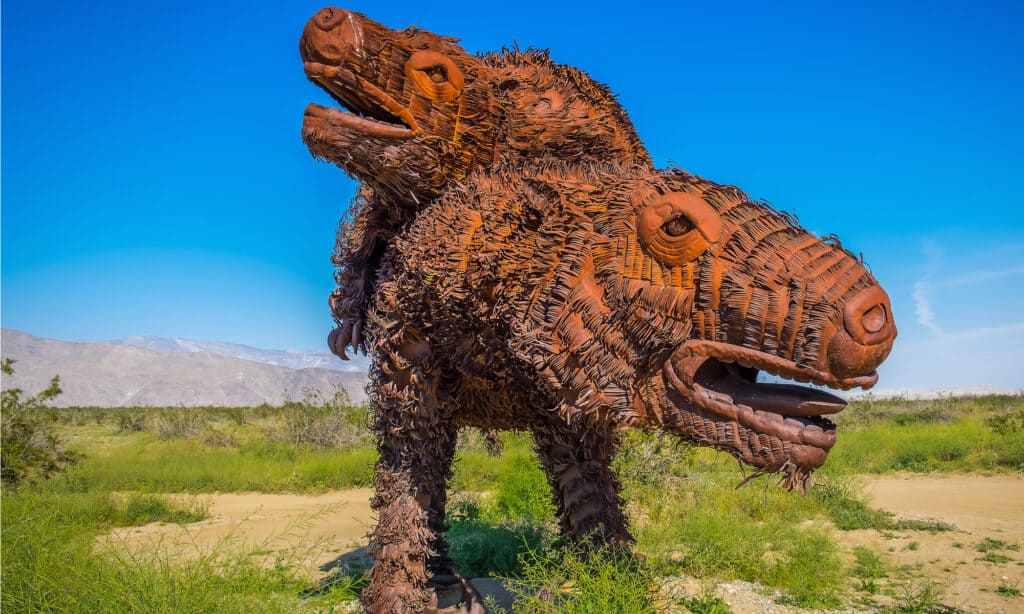
The Harlan’s ground sloth is an extinct genus of ground sloths that spent most of their time on the ground.
©eric laudonien/Shutterstock.com
| Harlan’s Ground Sloth | |
|---|---|
| Kingdom | Animalia |
| Phylum | Chordata |
| Class | Mammalia |
| Order | Pilosa |
| Family | Mylodontidae |
| Subfamily | Mylodontinae |
| Genus | Paramylodon |
| Living period | The Pliocene and Pleistocene epochs, about 4.9 million years ago to 11,000 years ago |
The Harlan’s ground sloth is an extinct genus of ground sloths that spent most of their time on the ground. The Harlan’s ground sloth was a giant, powerfully built sloth with strong claws, stout hind limbs, extremely large forelimbs, a massive chest, a short neck, and a huge tail. This species lived through the Pliocene and Pleistocene epochs, about 4.9 million years ago to 11,000 years ago.
These sloths were herbivores. They primarily ate sedges, grasses, and a few shrubs and trees. Records show that they were typically solitary animals who preferred limited social interactions. It’s also thought they were slow-moving and clumsy based on their physiology. Remains of Harlan’s ground sloths have been recovered from several sites in Oregon and preserved in the form of osteoderms in some local museums.
2. Conodonts

Conodonts existed in the world’s oceans from the Cambrian to the beginning of the Jurassic.
©Nobu Tamura email:[email protected] http://spinops.blogspot.com/ http://paleoexhibit.blogspot.com / CC BY-SA 4.0 – License
| Conodonts | |
|---|---|
| Kingdom | Animalia |
| Phylum | Chordata |
| Subphylum | Vertebrata |
| Class | Conodonta |
| Living period | From the Cambrian to the beginning of the Jurassic, about over 300 million years ago. |
Conodonts were an extinct animal species that were very similar to eels. They form part of Oregon’s earliest recorded fossils, along with different species of plants and corals. Conodonts existed in the world’s oceans from the Cambrian to the beginning of the Jurassic, roughly over 300 million years ago. These species were mainly distinguished by their tooth-like oral elements that sparked different interpretations about their feeding habitats.
Many researchers believe that the tooth-like structures were used as filter-feeding apparatus, filtering phytoplankton from the water. Other scientists interpreted these teeth as a “grasping and crushing array.” Knowledge about their soft issues remains limited.
3. Ichthyosaurs
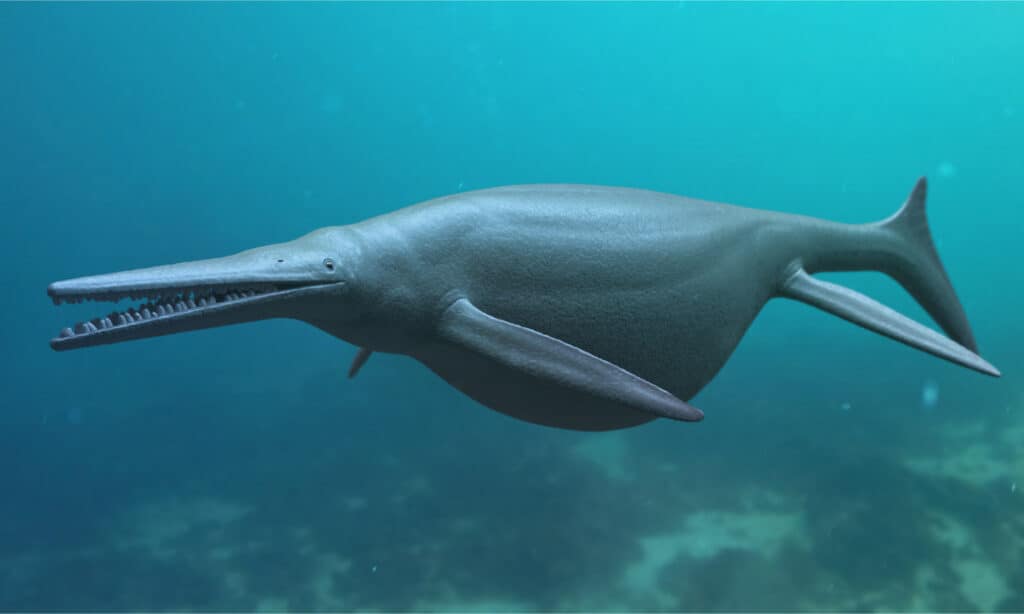
Ichthyosaurs were large extinct marine reptiles that thrived during the Mesozoic era.
©Giant Ichthyosaurus Aquatic Dinosaur 3D Rendered/Shutterstock.com
| Ichthyosaurs | |
|---|---|
| Kingdom | Animalia |
| Phylum | Chordata |
| Class | Reptilia |
| Clade | Eoichthyosauria |
| Order | Ichthyosauria |
| Living period | Mesozoic era; 250-90 million years ago |
Ichthyosaurs were large extinct marine reptiles that thrived during the Mesozoic era. The shallow seas covering Oregon during the Mesozoic Era were home to numerous species of ichthyosaurus. A few ichthyosaur fossils have been discovered in some parts of the state. Based on the recorded fossils, these marine reptiles first appeared about 250 million years ago and survived until roughly 90 million years ago.
Ichthyosaurs resembled modern-day fish and dolphins and measured between 3 and 66 feet. Their fore and hind limbs had been fully transformed into flippers. They had pointed heads, and their jaws were equipped with conical teeth for catching prey. Their eyes were huge, probably an adaptation for deep diving.
4. Aetiocetus
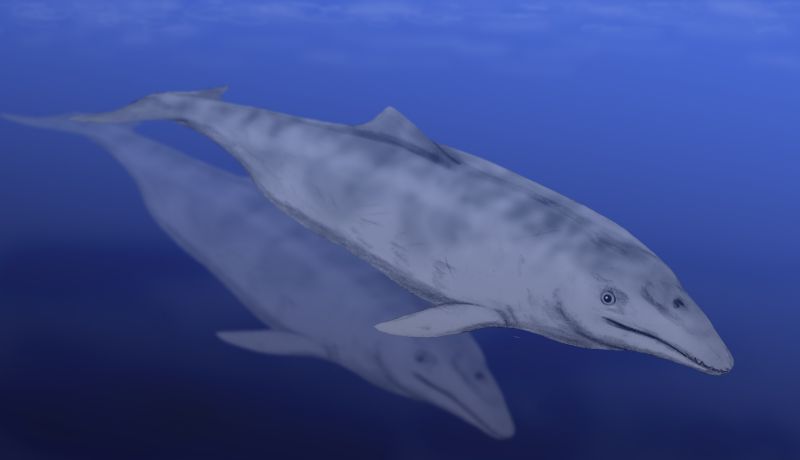
Aetiocetus is an extinct baleen whale that lived from about 33.9 to 23.03 million years ago.
©Nobu Tamura (http://spinops.blogspot.com) / CC BY 3.0 – License
| Aetiocetus | |
|---|---|
| Kingdom | Animalia |
| Phylum | Chordata |
| Class | Mammalia |
| Order | Artiodactyla |
| Infraorder | Cetacea |
| Family | Aetiocetidae |
| Genus | Aetiocetus |
| Living period | 33.9 to 23.03 million years ago, during the Oligocene |
Aetiocetus is an extinct baleen whale that lived from about 33.9 to 23.03 million years ago. It’s one of the complete prehistoric animals to be discovered in Oregon. Remains of a 25-million-year-old Aetiocetus with a fully developed set of teeth and baleen plates were found in the state. Oregon became the first to document Aetiocetus. You can find more details regarding the species from Oregon’s Yaquina Formation. Other Aetiocetus fossils have been discovered in Mexico and Japan.
5. Arctotherium
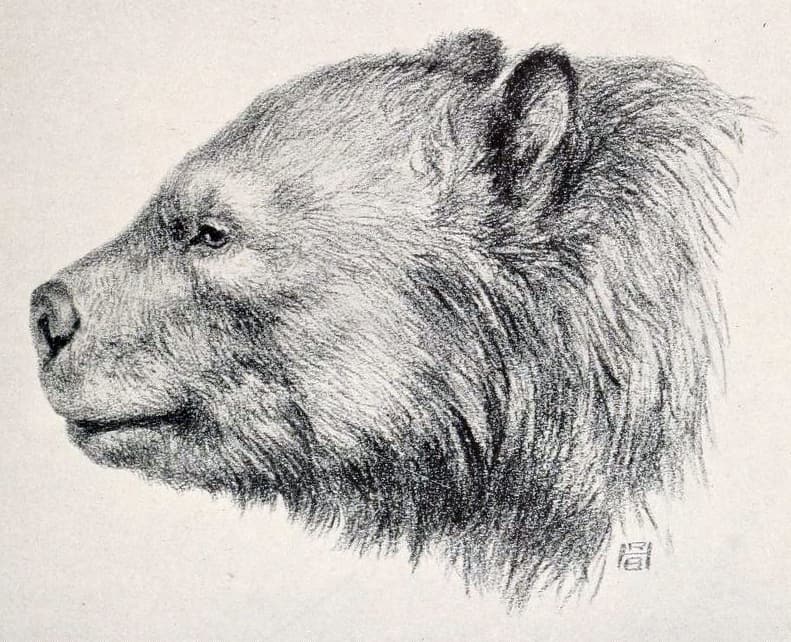
Actotheriums evolved millions of years ago and lived until the end of the last Ice Age.
© Robert Bruce Horsfall (1869–1948) / public domain – License
| Arctotherium | |
|---|---|
| Kingdom | Animalia |
| Phylum | Chordata |
| Class | Mammalia |
| Order | Carnivora |
| Family | Ursidae |
| Subfamily | Tremarctinae |
| Genus | Arctotherium |
| Living period | The Pleistocene epoch to the end of the last Ice Age, about 2 million years to 10,000 years ago |
Arctotherium is an extinct giant, short-faced bear endemic to Central and South America. Actotheriums evolved millions of years ago and lived until the end of the last Ice Age. Various attempts have been made to calculate each species’ body mass. These bears were estimated to weigh roughly 220 and 880 pounds, with large specimens weighing approximately 2,162 and 3,500 pounds. They measured anywhere between 11 and 12 feet tall on their hind legs.
Their fossils are rare and hard to come by, and we can’t say that any remains have been found in Oregon. Paleontologists have discovered a series of fossilized footprints in Lake County that closely resemble footprints from other states known to have been left by Arctotherium.
6. Thalattosuchia

Thalattosuchia is an extinct marine or sea crocodile that lived from the Early Jurassic to the Early Cretaceous.
©Nobu Tamura (http://spinops.blogspot.com) / CC BY-SA 3.0 – License
| Thalattosuchia | |
|---|---|
| Kingdom | Animalia |
| Phylum | Chordata |
| Class | Reptilia |
| Clade | Pseudosuchia |
| Superorder | Crocodylomorpha |
| Clade | Solidocrania |
| Suborder | Thalattosuchia |
| Living Period | Early Jurassic to the Early Cretaceous about ten million years ago |
Thalattosuchia is an extinct marine or sea crocodile that lived from the Early Jurassic to the Early Cretaceous about ten million years ago. Fossil specimens found in Oregon are believed to have drifted slowly from Asia via the intervening eons of plate tectonics. The early members of Thalattosuchia have been discovered in non-marine deposits.
7. Microtheriomys
| Microtheriomys | |
|---|---|
| Kingdom | Animalia |
| Phylum | Chordata |
| Class | Mammalia |
| Order | Rodentia |
| Family | Castoridae |
| Subfamily | Castoroidinae |
| Genus | Castoroides |
| Living period | Last great Ice Age- about 35 million to 30 million years ago |
Microtheriomys is a large extinct species of beaver. Researchers at the John Day Fossil Beds discovered the remains of a 30 million-year-old Microtheriomys in May 2015. Unlike modern-day beavers, microtheriomys didn’t have sturdy enough teeth to build dams and gnaw down trees. Instead, they primarily fed on soft leaves.
8. Mosasaurs
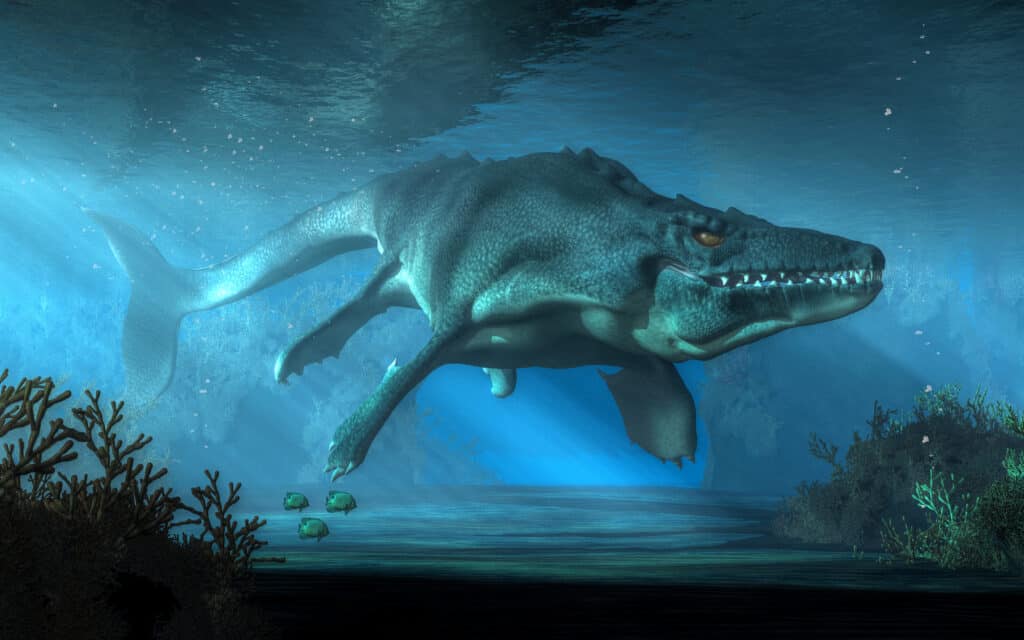
Mosasaurs measured approximately 36 to 56 feet long.
©Daniel Eskridge/Shutterstock.com
| Mosasaurs | |
|---|---|
| Kingdom | Animalia |
| Phylum | Chordata |
| Class | Reptilia |
| Order | Squamata |
| Clade | Pythonomorpha |
| Superfamily | Mosasauroidea |
| Extinct since | 66 million years ago |
Mosasaurs were a group of extinct, giant marine reptiles that lived until about 66 million years ago. Mosasaurs measured approximately 36 to 56 feet long and weighed up to 40,000 pounds. Their body shapes were similar to modern-day monitor lizards, though they were a bit elongated and streamlined for swimming. They had flexible skulls and double-hinged jaws, which enabled them to gulp down prey. Mosasaurus fossils have been found in various parts of Oregon.
9. Plesiosaurs
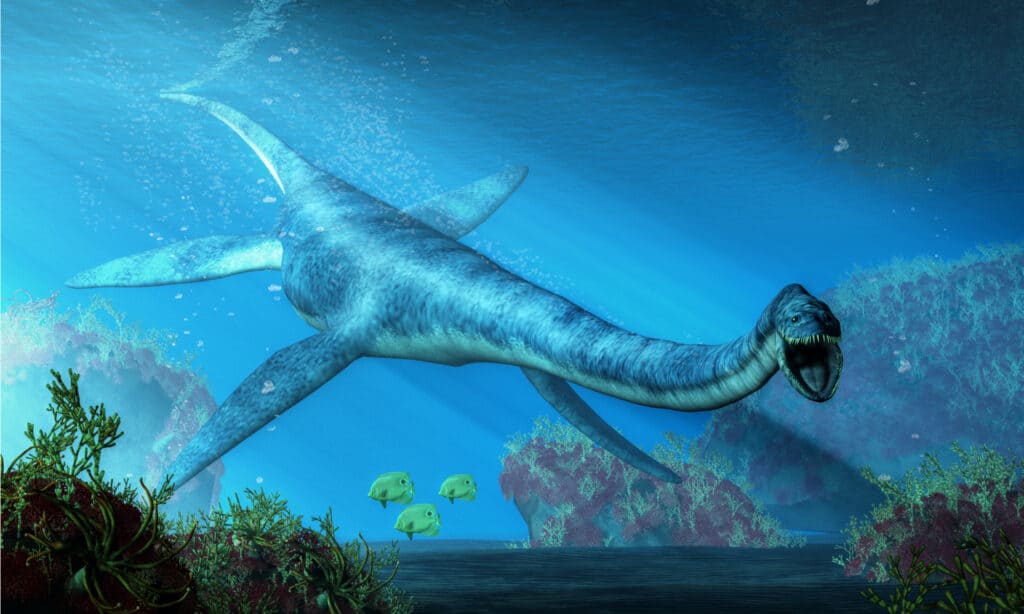
Plesiosaurs were an extinct group of long-necked marine reptiles from 215 million to 66 million years ago.
©Daniel Eskridge/Shutterstock.com
| Plesiosaurs | |
|---|---|
| Kingdom | Animalia |
| Phylum | Chordata |
| Class | Reptilia |
| Superorder | Sauropterygia |
| Clade | Pistosauria |
| Order | Plesiosauria |
| Living period | 203–66 million years ago |
Plesiosaurs were an extinct group of long-necked marine reptiles from 215 million to 66 million years ago. This species measured 15 to 43 feet long and had a broad, flat body with a relatively short tail. They were widely distributed in the European and Pacific oceans, including Asia, North America, and Australia. In 2003, paleontologists discovered parts of plesiosaur skulls in Cretaceous rocks near Mitchell, Oregon. The marine reptile measured 25 feet long and was estimated to have lived about 80 to 90 million years ago.
10. Pterosaurs
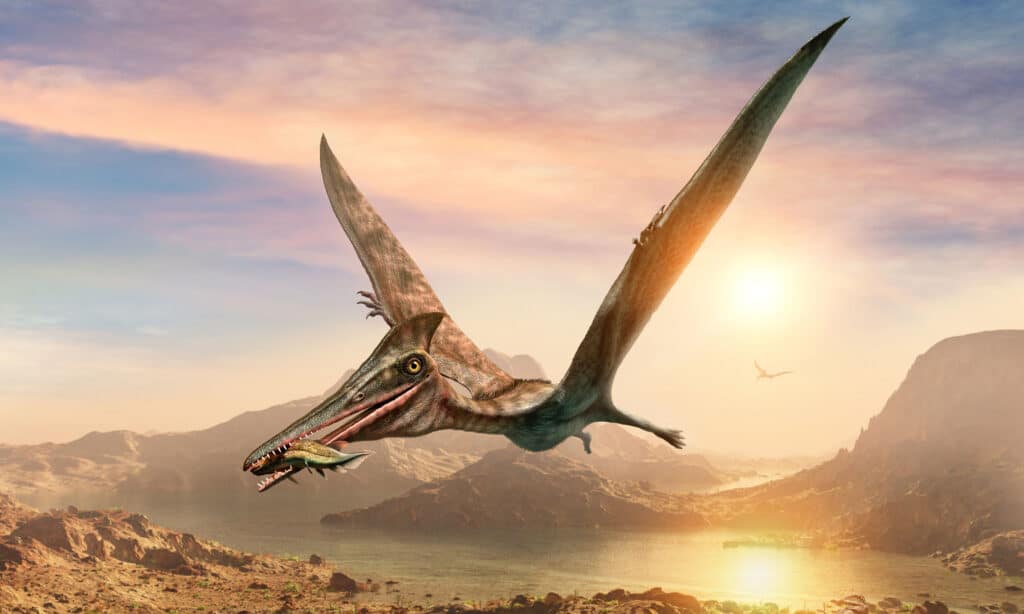
Pterosaurs are extinct species of reptiles that existed from the Late Triassic to the end of the Cretaceous.
©iStock.com/Warpaintcobra
| Pterosaurs | |
|---|---|
| Kingdom | Animalia |
| Phylum | Chordata |
| Clade | Ornithodira |
| Clade | Pterosauromorpha |
| Order | Pterosauria |
| Living period | Mesozoic era, from the Late Triassic to the Late Cretaceous, some 228 to 66 million years ago |
Pterosaurs are extinct species of reptiles that existed from the Late Triassic to the end of the Cretaceous, about 228 to 66 million years ago. They were the earliest vertebrates to have evolved with powered flight. Pterosaurs came in different sizes, with the smallest species having a wingspan of no less than 10 inches. Fossils of pterosaurs have been found in Cretaceous sediments deposited in the ancient sea covering the state.
Summary Of The 10 Extinct Animals That Lived In Oregon
| Rank | Animal | Date Existed |
|---|---|---|
| 1 | Harlan’s Ground Sloth | about 4.9 million years ago to 11,000 years ago |
| 2 | Conodonts | about over 300 million years ago |
| 3 | Ichthyosaurus | 250-90 million years ago |
| 4 | Aetiocetus | 33.9-23.03 million years ago |
| 5 | Arctotherium | about 2 million years to 10,000 years ago |
| 6 | Thalattosuchia | about 10 million years ago |
| 7 | Microtheriomys | about 35 million to 30 million years ago |
| 8 | Mosasaurs | 66 million years ago |
| 9 | Plesiosaurs | 203–66 million years ago |
| 10 | Pterosaurs | some 228 to 66 million years ago |
The photo featured at the top of this post is © Michael Rosskothen/Shutterstock.com
Thank you for reading! Have some feedback for us? Contact the AZ Animals editorial team.






